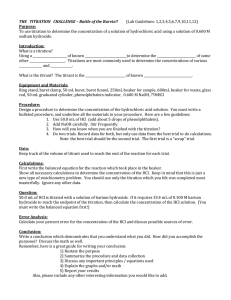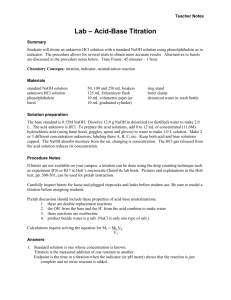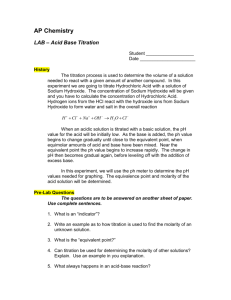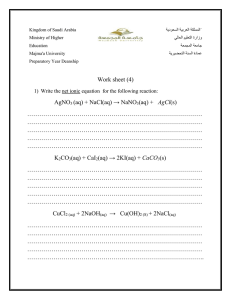Acid/Base Titration
advertisement
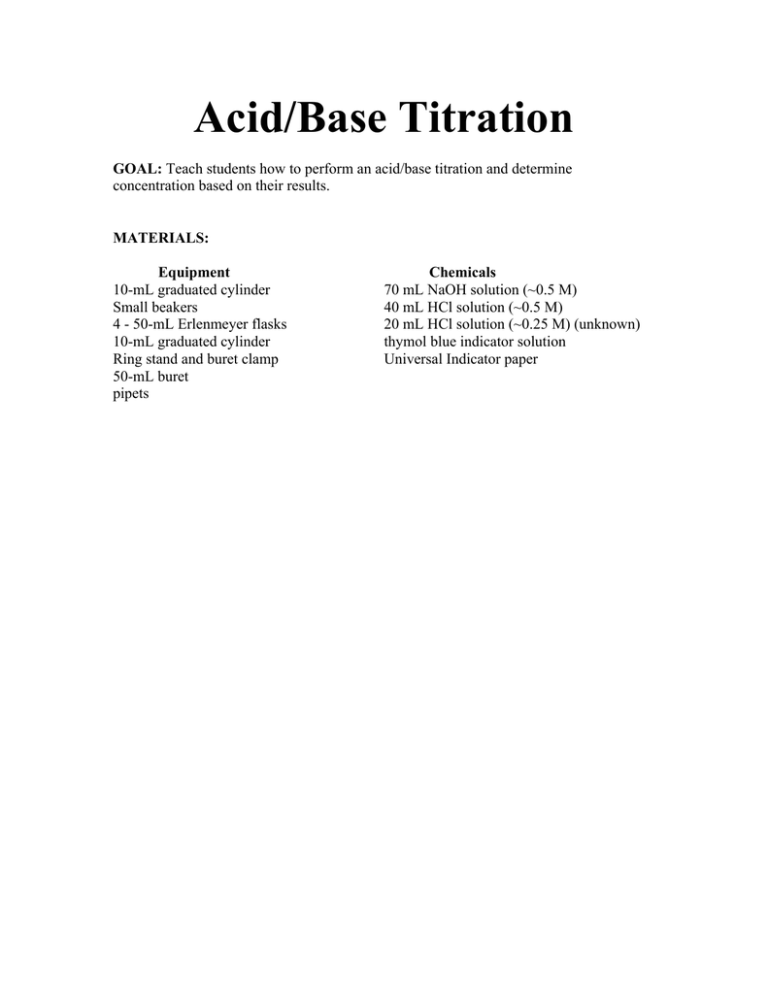
Acid/Base Titration GOAL: Teach students how to perform an acid/base titration and determine concentration based on their results. MATERIALS: Equipment 10-mL graduated cylinder Small beakers 4 - 50-mL Erlenmeyer flasks 10-mL graduated cylinder Ring stand and buret clamp 50-mL buret pipets Chemicals 70 mL NaOH solution (~0.5 M) 40 mL HCl solution (~0.5 M) 20 mL HCl solution (~0.25 M) (unknown) thymol blue indicator solution Universal Indicator paper DEMONSTRATION/DISCUSSION: You will need: 2 - 10 mL graduated cylinder (1 for acid, 1 for base) 4 – 50 (or 100) mL beakers 20 mL .5 M HCl 20 mL .5 M NaOH Universal Indicator Paper Thymol Blue indicator 1. Prepare 4 beakers: a. 2 with 10 mL of 0.5 M HCl b. 2 with 10 mL of 0.5 M NaOH 2. In the first demonstration you will need 10 ml of the acid and 10 ml of the base (from step one) and Universal Indicator paper: a. Ask the students if they remember (from the previous lesson) what universal indicator paper (pH paper) is and why it is used. Ask them to predict what color change of the indicator paper will occur if the paper is placed in HCl (acid) and NaOH (base) solutions. b. Test their predictions with the indicator paper. The acid should turn the paper red and the base should turn it blue. Point out that both the acid and base are very strong. c. When you mix together equal amounts of strong acid and base – neutralization occurs. i. “Equal amounts” means that there is the same number of mols of the acid and the base. How do we calculate the number of mols in each solution? concentration (M) x volume (V) = mols (mols/L) x L = mols (.5 mols/L) x .01 L = .005 mols Since we have 10 mL (.01 L) of a .5 M solution of the acid and 10 mL (.01 L) of a .5 M solution of the base. Both solutions have the same number of mols. ii. Slowly pour the base into the acid, then test the pH of the mixture with pH paper. The pH paper should change to a yellow color, indicating a neutral pH (~7), thus “neutralization” reaction has occurred. 3. In the second demonstration, you will need 10 ml of the acid and 10 ml of the base (from step one) and Thymol Blue indicator. a. Tell students that a liquid indicator, such as Thymol Blue, does the same thing as indicator paper. i. Put a few drops of Thymol Blue in the beaker with acid. The solution should turn RED. ii. Put a few drops of Thymol Blue in the beaker with base. The solution should turn BLUE. Therefore we can tell if a solution is acidic or basic based on the color change of the indicator in solution. 4. Liquid indicators (such as Thymol Blue) are useful because they allow us to do titrations. A “titration” is an experimental technique that allows us to determine the concentration (mols/L) of an acid or base solution. (Use titration apparatus to explain procedure.) a. Titration Procedure: i. Base with known concentration is in buret. ii. Acid with known volume, but unknown concentration is in beaker. iii. A couple drops of indicator are added to the beaker with acid. (Solution turns red.) iv. Base (in buret) is slowly added to the acid in the beaker. v. As base is added, the pH of the solution changes. It becomes less acidic until it reaches neutral (indicator will turn slightly yellow – but this is not always seen). This is called the “end point”. An additional drop of base will turn the solution basic, thus the indicator in the solution will turn blue. b. The concentration of the acid solution can be calculated with the equation: *NOTE: Remind the students that M (mols/L) x L = mols. Therefore, what does the below equation tell us? ! In a titration, we can calculate the concentration or volume of an acid or base as long as there are equal amounts (same number of mols) of each. This occurs at the “end point”. Mbase x Vbase = Macid x Vacid where Mbase = concentration (mols/L) of base Vbase = volume of base needed to turn acid solution basic Macid = concentration (mols/L) of acid (unknown) Vacid = volume of acid in beaker 5. As we discussed before, when a base and an acid are mixed, a neutralization reaction occurs. Specifically, the reaction we will be looking at is: HCl(aq) + NaOH(aq) ! NaCl(aq) + H2O(l) (acid) (base) (neutral) (neutral) (salt) (water) The products of a neutralization reaction are salt and water, which are both neutral (pH = 7). At the end point of the titration, there is an equal amount (same number of mols) of NaOH and HCl in the beaker, therefore all of the HCl is reacted with NaOH to make NaCl and water. When an additional drop of NaOH is added to the solution, there is no more HCl to react with the NaOH. Therefore, the solution becomes basic because you have unreacted NaOH (basic) and NaCl (neutral) and water (neutral). We can see this change in pH by the change in the color of the indicator in the solution. We can then use Mbase x Vbase = Macid x Vacid to determine the concentration of the acid. *NOTE: We can reverse this experiment (acid of known concentration in buret and base of unknown concentration in beaker) and use the same equation to calculate the concentration of base. EXAMPLE: Suppose you have 25 mL (0.025 L) of HCl in a beaker, but you don’t know the concentration of the HCl solution. Therefore, you perform a titration to figure it out. If 12.5 mL (0.0125 L) of 1 M NaOH solution was dispensed from the buret to reach the end point, then what is the concentration of the HCl solution? Mbase x Vbase = Macid x Vacid (1 mol/L NaOH) x (.0125 L NaOH) = (? mols/L HCl) x (.025 L HCl) ? mols/L HCl = [(1 mol/L NaOH) x (.0125 L NaOH)]/ .025 L HCl = .5 mols/L HCl Procedure *NOTE: Make sure students where goggles and plastic gloves at all times! TITRATION OF UNKNOWN #1: 1. Use a buret clamp to secure the 50-mL buret to a ring stand. 2. Obtain 50 mL of sodium hydroxide (NaOH) solution (~0.5 M) in a small beaker. 3. Use a funnel to fill the buret with sodium hydroxide solution. Open the stopcock long enough to fill the tip with solution and remove any air bubbles. Add solution to the top of the buret, or drain the solution through the stopcock, to bring the level close to 0.0 mL on the buret scale. It is not necessary that the initial level is exactly 0.0 mL, but it must be at or below the start of the scale. 4. Record the initial level of the buret on data sheet, keeping your eye level with the bottom of the meniscus. (Students will need help with this.) 5. Obtain approximately 10 mL of unknown HCl solution #1 (~0.5 M). 6. Using a 10-mL graduated cylinder, transfer 10-mL portions of the HCl solution into each of two clean 50-mL Erlenmeyer flasks. 7. Add several drops of thymol blue indicator to each flask. 8. Titrate the acid solution to the end point (the first permanent appearance of blue in the solution). Add the base rapidly at first as you continuously swirl the flask and its contents to ensure rapid mixing. As you approach the end point, continue the addition of base more slowly – eventually drop by drop – mixing carefully after each addition. With practice, it is possible to determine the endpoint with the precision of one drop. 9. Record the final volume in the buret. 10. Repeat the titration on the other 10-mL unknown HCl solution #1(0.5 M) sample. Check the volume of sodium hydroxide that you have left in the buret. Make sure that you have enough to perform the second titration. TITRATION OF UNKNOWN #2: Use procedure above for 10 mL of unknown HCl solution #2 (0.25 M). Record initial and final volumes of NaOH (0.5 M) on data sheet. Name_________________________ Acid-Base Titrations EXAMPLE Suppose you have 25 mL (0.025 L) of HCl in a beaker, but you don’t know the concentration of the HCl solution. Therefore, you perform a titration to figure it out. If 12.5 mL (0.0125 L) of 1 M NaOH solution was dispensed from the buret to reach the end point, then what is the concentration of the HCl solution? DATA TITRATION of UNKNOWN #1 Titration 1 Titration 2 Final buret volume _________________ Final buret volume _________________ Initial buret volume _________________ Initial buret volume _________________ Volume of NaOH _________________ Volume of NaOH _________________ TITRATION of UNKNOWN #2 Titration 1 Titration 2 Final buret volume _________________ Final buret volume _________________ Initial buret volume _________________ Initial buret volume _________________ Volume of NaOH _________________ Volume of NaOH _________________ Results 1. For the titration of UNKNOWN #1, calculate the concentration of the HCl solution using the data from each titration. Titration 1, [HCl]: _______________ Titration 2, [HCl]: _______________ 2. For the titration of UNKNOWN #2, calculate the concentration of the HCl solution using the data from each titration. Titration 1, [HCl]: _______________ Titration 2, [HCl]: _______________ Questions 1. In the reaction of hydrobromic acid ( HBr) and sodium hydroxide ( NaOH ), which of the following is formed? A. NaBr B. NaH C. H3O+ D. OH- 2. How many milliliters of 0.45 M hydrochloric acid (HCl) must be added to 25.0 mL of 1.00 M potassium hydroxide to make a neutral solution? A. 11 mL B. 56 mL C. 0.02 mL D. 25 mL


